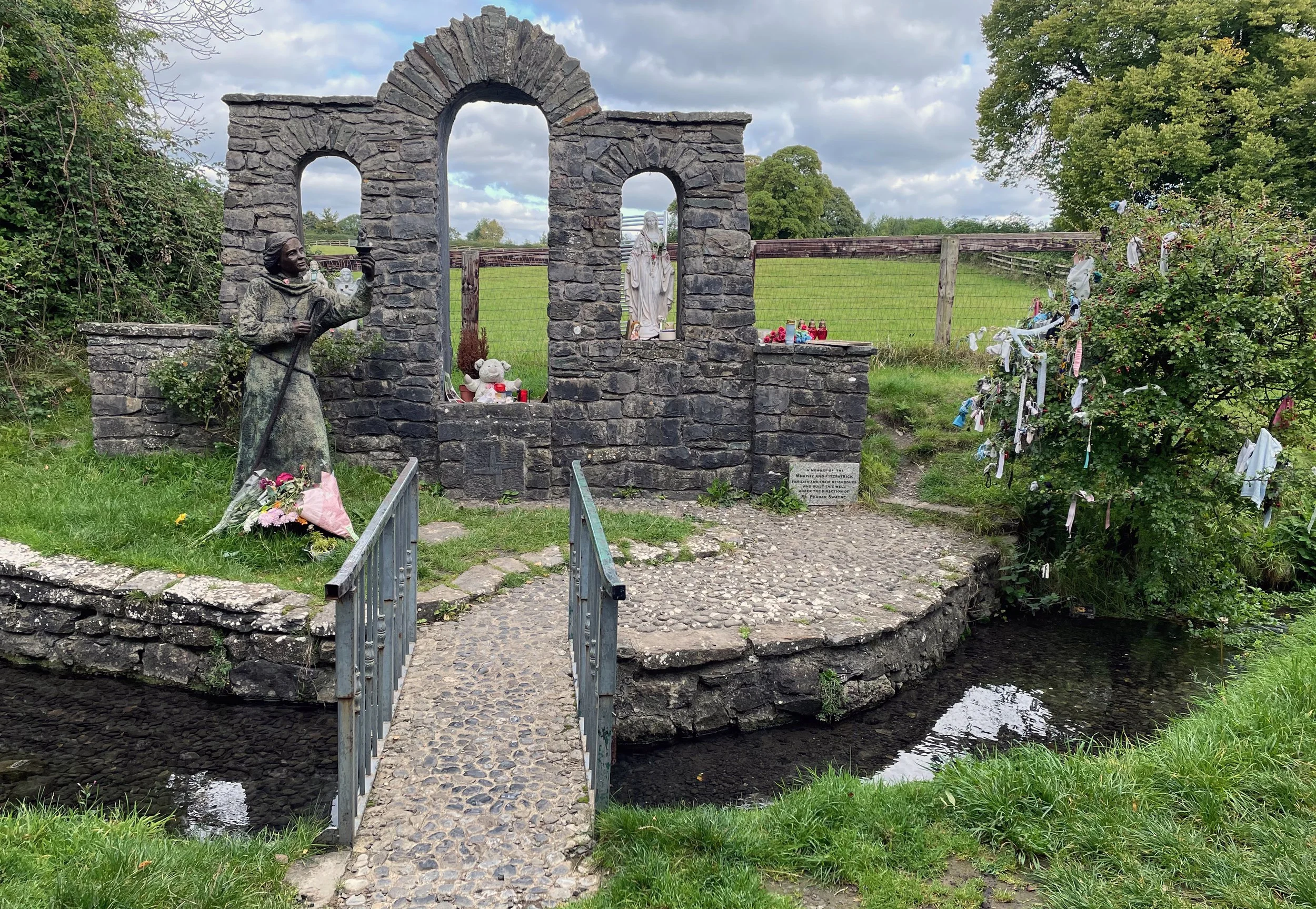Following Brigid’s Way Pilgrimage in Ireland
By Elyn Aviva
It was time to walk a pilgrimage road again. Forty years ago, I first walked the 500-mile-long Spanish Camino de Santiago (Camino Francés) as part of my PhD in anthropology. Twenty years ago, Gary (my beloved husband) and I walked part of the French Chemin de St Jacques from Le Puy-en-Velay in gratitude for my recovery from cancer. The memories of spending weeks walking quietly in nature, of challenging my limits, have resonated throughout my life.
I wanted to honor these milestones, but Gary was now 85 and I was 75. The pilgrimage had to be shorter and flat. I poured over routes without success. I wanted a “real” pilgrimage, not a snippet of a longer one. Then I remembered Brigid’s Way, a recently (2012) constructed Irish pilgrimage on country roads that leads 90 miles from St. Brigid’s birthplace in Faughart to the location of her medieval church in Kildare. The Way isn’t marked, but a description is available online.
Brigid’s Way ticked all the boxes: flattish countryside, doable in two weeks of walking six to eight miles a day, and purposeful. It also honors the Divine Feminine. Brigid is both an ancient Celtic goddess and a real person, St. Brigid, who lived around 464 – 524 CE. St. Brigid “took over” parts of pagan goddess Brigid’s “portfolio” of hearth, forge, poetry, wisdom, protection, and domesticated animals. St. Brigid also has additional attributes: miraculous healing, holy wells, beer-brewing, and generosity. Her magical mantle is said to protect those who call on her, even today.
Gary and I can no longer walk long distances and carry backpacks, and accommodation is sparse in rural Ireland, so I devised a complicated “two steps forward, one step back” itinerary. We would walk out from our hotel, then get a ride back by bus or taxi. The next day we would get a ride to where we had stopped walking, walk on from there, then get a ride back. We would change hotels and transfer luggage every few days. The schedule took days to arrange and was a logistical nightmare.
I reached out on Facebook, and Elaine Misselaineous, a Brigid’s Way volunteer, contacted Sally Cox, whose extensive estate is six miles south of Faughart and on Brigid’s Way. Sally invited us to stay with her. Elaine contacted Dolores Whelan, a co-founder of Brigid’s Way, and Dolores offered to start us on our pilgrimage with ritual and prayers.
Excited and a bit apprehensive, Gary and I set our intentions to say “Yes” to whatever Brigid—and our journey—offered to us. We flew from Lisbon to Dublin on a Saturday, and Sally welcomed us with abundant, Brigid-style hospitality. Several of her friends dropped by that evening, bringing food, music, and conversation—and, probably, checking us out.
We expected to start walking on Sunday, but Saturday evening the weather forecast turned dire—torrential rain. Exhausted from our trip and all the conversation, we went to bed thinking, “What a relief! We’ll sleep in.”
But Sunday morning came and the sun was shining. Dolores arrived and drove us to the old Faughart cemetery. She lit a candle using a flame lit from Brigid’s perpetual flame in Kildare; she recited prayers; and she offered us the opportunity to state our intentions for our pilgrimage. Words came to me: “I set my intention to walk in faith, trust, truth, and beauty—and in service for the highest good!” And, as an afterthought, I silently asked for Brigid’s magical mantle to protect us on our journey.
After showing us the holy well and ancient stones at St Brigid’s nearby shrine, Dolores sent us on our way. En route, we visited a church with a relic (piece of skull) of St. Brigid and met a man who told us about a life-saving miracle St. Brigid’s holy water had performed for his newborn son. We met people out for an afternoon stroll, wearing fluorescent vests to make sure they were visible to the cars with whom we shared the narrow, rural roads. Tired but exhilarated, we made it six miles to Sally’s and collapsed.
Our plan for Monday had been to walk six miles south on Brigid’s Way, but Sally had other ideas. We needed to walk her land and see several ancient megalithic sites. We had agreed to say “Yes” to whatever we were offered, so soon we were being guided by Sally’s knowledgeable young friend, Pádraig O’Cumascaigh. He made the landscape come alive with his vivid stories. That evening, Sally’s friends stopped by again, including Jo, who played the piano and sang.
Tuesday, we planned to walk Brigid’s Way—but once again, Sally had other plans. There was still so much more to see before we left. Then it was Wednesday, and we had hotel reservations in Slane, 24 miles to the south. Sally offered to drive Pádraig and us there, following the country roads we would have walked and visiting the Brigid- and Irish-mythology-related sites we would have seen. But Pádraig got stung by a wasp, and Sally’s broken back was acting up, so her friend Anne offered to drive us to Slane. Not on Brigid’s Way but on the freeway.
And so it was. And so it continued to be. Every plan changed at least once, sometimes twice or three times. Four hotel rooms in three nights in Slane. A friend who agreed to meet us but couldn’t. Two friends we hadn’t known were in Ireland, who offered to meet us on the Hill of Tara. Barry, the taxi driver who picked us up (without charge), even though he wasn’t working, because he was in the neighborhood and no other taxi was available. Our host, Karen, in Robertstown, who drove us to an award-winning pub 20 minutes away, and two days later drove us to Kildare, stopping at Brigid sites along the way. Our friends Brad and Rita, who just happened to be in Kildare when we finished our pilgrimage, and who saw our exhaustion and invited us to join their Illuminated Journeys tour group for a few days before we flew back home to Portugal.
This pilgrimage was nothing like what I had expected. Rather than a pilgrimage about walking in nature and physical endurance, it was about sinking deep into the landscape, legends, and lives of people we met along the way. Instead of our pilgrimage being a literal walk on Brigid’s Way, we were given the opportunity to follow Brigid’s Way—to live in trust and faith and compassion, to be generous to others, to be open to possibility. To accept the help of the many people who served as Brigid’s “hands”—and to commit to being her “hands” on this earth for others.
Elyn Aviva is a transformational traveler, writer, and fiber artist who is currently living in Sintra, Portugal, with her husband, Gary White. She has written numerous books on pilgrimage and powerful places. She and Gary co-author “Powerful Places” guidebooks. To learn more, visit www.pilgrimsprocess.com, www.fiberalchemy.com, and “Elyn Aviva Writes” on Facebook.














